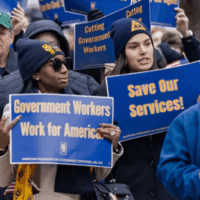Measure would return Baltimore, once a leader on wages, to forefront of national movement to raise pay
Washington, D.C.— Councilwoman Mary Pat Clarke of Baltimore City, together with a coalition of community, faith and worker groups, will introduce a bill Monday to raise Baltimore City’s minimum wage to $15 by 2020. The bill would also gradually eliminate the sub-minimum wage for tipped workers in Baltimore City, currently set at $3.63 per hour, so that tipped workers would be entitled to the full minimum wage by 2024. About 80,000 workers in Baltimore City, or more than one-fifth of the City’s workforce, would receive a much needed raise if the measure succeeds.
The move towards $15 in Baltimore follows last week’s nationwide Fight for $15 fast-food strikes and comes just two weeks after California Gov. Jerry Brown and New York Gov. Andrew Cuomo signed bills that will increase their states’ minimum wage to $15.
“There’s a growing recognition across the country that $15 is the bare minimum workers need to get by,” said Christine Owens, executive director of the National Employment Law Project. “Raising Baltimore’s minimum wage to $15 builds upon the city’s historical commitment to a local minimum wage that meets residents’ needs and comes at a crucial time for workers who are struggling to make ends meet.”
Since the Fight for $15 began in New York three-and-a-half years ago, 17 million workers have gotten raises through a combination of new state and local laws, executive orders, and individual companies raising their pay scales. Of those, 10 million will see their wages go up to $15 an hour. Fifty-one states, cities, and counties have raised their minimum wage since 2012.
Baltimore enacted one of the nation’s first city minimum wage laws in 1964 because it found that the federal and Maryland minimum wages were not high enough to enable working people to maintain a minimal standard of living. But it is badly outdated and Baltimore workers today, like workers all over the country, have seen the value of their wages decline for years as income inequality has soared. From 2000 to 2012, wages were flat or declined for the bottom 70 percent of the U.S. workforce, and in 2012, the top 10 percent of earners took more than half of the country’s total income.
The Economic Policy Institute’s Family Budget Calculator estimates that a single worker in the Baltimore/Towson metro area needed to earn $33,994 a year in 2014—or approximately $16 per hour—to make ends meet. A single worker supporting a child needed $59,134 a year, or about $28 per hour. Moreover, about 24 percent of Baltimore City residents have an income below the poverty level, and more than one-fifth of the City’s households receive food assistance.
The Baltimore campaign’s push to eliminate the sub-minimum wage for tipped workers would also bring about much-needed relief for tipped workers facing an especially hard time supporting themselves and their families. Tipped workers are almost two times more likely to live in poverty than other workers, and they are disproportionately women. Seven states and a growing number of cities and counties already require employers to pay tipped workers the full minimum wage; this policy provides tipped workers with a stable and readily enforceable base income to help offset wide fluctuations in pay and reduces the risk that workers will not earn enough in tips to bring them to the full minimum wage.
Baltimore’s $15 minimum wage proposal shows that the Fight for $15 movement is poised to bring more historic victories and raises for low-wage workers this year. Legislators in Montgomery County, Maryland, and voters in Washington, D.C., this November will be considering $15 minimum wage proposals. Washington, D.C.’s Mayor Muriel Bowser has also announced that she will introduce a $15 minimum wage bill. Outside of the Washington D.C. and Maryland area, advocates in Maine, Washington, Colorado, and Arizona are working to place significant minimum wage increases on this year’s ballot, and numerous other state and local campaigns are also gaining momentum.
###
Related to
The Latest News
All newsMayor Bowser & D.C. Council Must Respect the Will of D.C. Voters by Rejecting Repeal of Initiative 82

Blog
New Brief Sheds Light on the Amazon’s Dangerous ‘Flex’ Labor Model

News Release
NELP Denounces Supreme Court Ruling Permitting Immediate Layoffs of Hundreds of Thousands of Federal Workers

News Release
